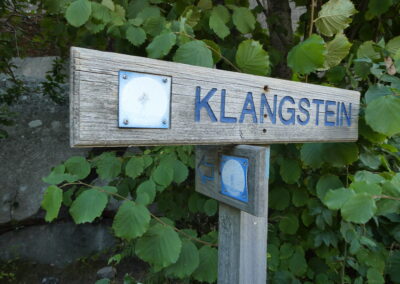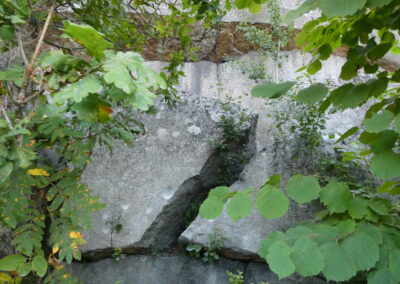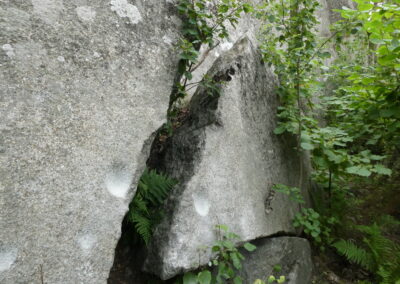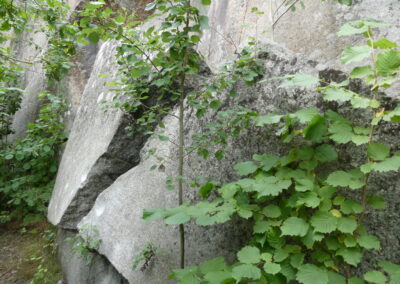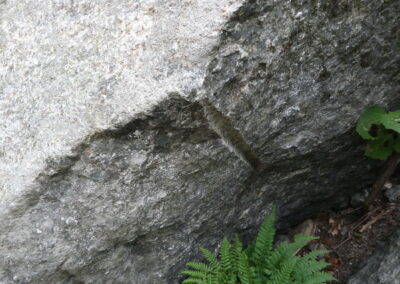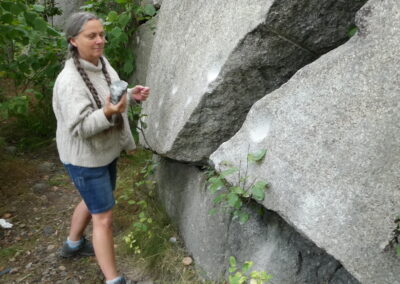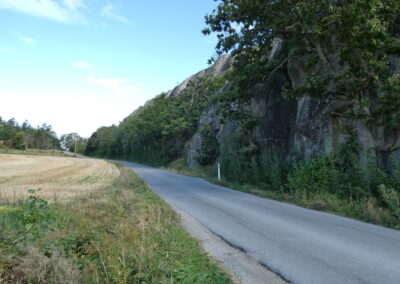The Ringing Stone at Vesterøya
Local name: Klangsteinen, Den lye steinen
Locality
County: Vestfold and Telemark
Municipality: Sandefjord
Location: Bentserødkollen, Tveitan, Vesterøya
The stone is found on the western side of Bentserødkollen, by Vesterøyveien, approximately 850 meters south of the farm Tveitan. There is a sign at the roadside marked ‘klangstein’ on the east side of the road, just west of Rørvikåsen.
Description
There are two boulders close to the rock wall (Bentserødkollen), which goes parallel to the road. The two boulders were formerly one that has previously been part of the rock wall a few meters further up; one can clearly see that the boulders once belonged to the solid rock. The two boulders have a total width of around 4 meters, while the height is 2–2.5 meters. The thickness is 60–80 cm. Incuding a third smaller boulder, the original block may have been approximately 10–12 cubic meters. Drill holes after the block was divided into two (cf. local tradition, see below) are still visible, see photo. At the bottom, near the fracture surface, there are several wear marks from playing, the two largest with a diameter of 12–14 cm and a depth of 3–4 cm. The best sound is in this place. Nevertheless, the boulders gives sound all over, and you can clearly feel the vibration in them when you play. There are no other stones or parts of the rock nearby with a sound like this one. The sound from playing echoes from Rørvikåsen on the other side of the field to the west, cf. sound recording.
Cultural history and og tradition
Old people in the local community have known about the stone, and they say that it was blown up many years ago by someone who wanted to find out what the stone consisted of. According to Roger Davidsen, in the book Et sted i Sandefjord. Lokalhistorisk stedsnavnleksikon [‘A place in Sandefjord. Local historical place name lexicon’] (Sandar historielag 2008), there was a servant boy on the farm Tveitan who, after the turn of the last century, wanted to see what was inside it. He drilled a hole and ‘blew the slab into several parts. The only thing he achieved was that the sound partially disappeared’ (p. 48). Stories like this, saying that the sound was lost or significantly reduced are—interestingly—found in connection with other stones, elsewhere in the country. The stone at Vesterøya is today known as Klangsteinen, and is marked on various maps and in a brochure of points of interest in Sandefjord municipality. At the roadside there is a sign pointing to the stone.
The stone was previously called ‘Den lyse steinen’ (The light stone), according to Davidsen (page 36). It is probably more likely that the name was ‘Den lye steinen’ (The stone for listening), which is also confirmed by an article in the magazine Naturen. Illustrert månedsskrift for populær naturvidenskap [‘Naturen. Illustrated monthly magazine for popular science’] for 1932 (p. 95). There, Haakon Hougen writes about the boulder at Bensterødkollen, in a short article—as a comment to an article about the ringing stone at Aga, Hardanger, the previous year. Here is Hougen’s article in its entirety:
Pendant til ‘Klokkesteinen på Aga’ [Pendant to The Ringing Stone at Aga] (Naturen, issue 7–8, 1931). Under a steep rock wall at Vesterøen in Sandeherred (Vestfold) there is a large, flat boulder leaning against the mountainside. The stone was blown into 2 parts many years ago. It is of the same gray syenite as the rock, and its upper fracture surface, which exactly corresponds to a fracture line higher up the hill, shows that it has crashed straight down where it now is situated. Due to the hollow support, it gives a clear bell-like tone when you beat it with small stones, and numerous marks show that there are not few people who in the course of time have had fun, listening to ‘Den lye steinen’ [The stone for listening]. Old people at the place tell that when the stone was still in one piece, its sound was much stronger than now, and enticed by the metallic sound a man detonated an explosive device in the middle of it, in the belief that he would find silver or another ‘treasure’. The result was, of course, just graystone, and that there are now two ‘lye steiner’ instead of one. But the two parts still ring, one half with a somewhat deeper sound than the other; but the sound is neither as pretty nor as strong as when the stone was whole, the old people say. Haakon Hougen.
Many thanks to Mikarl Arnt Andersen Tveitan and Sylvelin Hege Sevilhaug.
